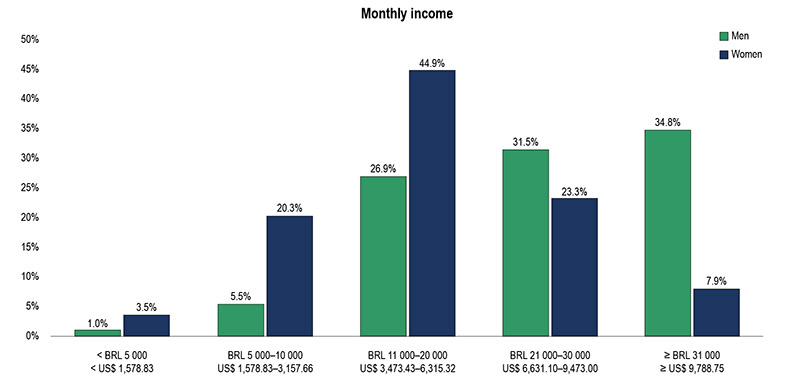Volume 113, Nº 1, July 2019
DOI: http://www.dx.doi.org/10.5935/abc.20190089
ORIGINAL ARTICLE
The Profile of the Brazilian Cardiologist – A Sample of Members of the Brazilian Society of Cardiology
Lucas Simonetto Faganello
Mauricio Pimentel
Carisi Anne Polanczyk
Tiago Zimerman
Marcus Vinicius Bolivar Malachias
Oscar Pereira Dutra
Leandro Ioschpe Zimerman
Dr. Lucas Simonetto Faganello

Figure 3 – Salary difference between men and women.
Abstract
Background: Data from the international literature have shown changes in the profile of cardiologists and in their medical practices. However, there is no data on this in Brazilian cardiologists.
Objective: To evaluate professional and personal characteristics of a sample of Brazilian cardiologists.
Methods: This was a cross-sectional study; a questionnaire was sent by e-mail to cardiologists, active members of the Brazilian Society of Cardiology in 2017. The results were analyzed, and the level of significance set at p < 0.05.
Results: The questionnaire was sent to 13,462 cardiologists, with 2,101 (15.6%) respondents, mostly men (71.8% versus 28.2%). Age distribution and marital status were significantly different between the sexes (p < 0.001). The number of cardiologists without children was higher among women (40.5% versus 16.1%; p < 0.001). The most common place of work was the public hospital (46.5%), followed by private hospital (28.5%) and private office (21.1%). The office was the main place of work for 23.9% of men and 14% of women (p < 0.001), with predominance of individuals older than 50 years (31.7% versus 10.1%, respectively; p < 0.001). Most cardiologists (64.2%) worked more than 40 hours a week (69% of them men and 51.9% of the women; p < 0.001). Eighty-eight percent of the sample earned more than BRL 11,000 (US$ 3,473.43), and 66.5% of the men earned more than BRL 20,000 (US$ 6,315.32) per month, versus 31.2% of the women (p < 0.001). A high level of work-related stress was reported by 11.3% of respondents.
Conclusion: Most cardiologists were men, who showed higher workload and higher income; 11.3% of the cardiologists perceived stress as a great deal. (Arq Bras Cardiol. 2019; 113(1):62-68)
Keywords: Cardiologists; Survey and Questionnaires; Income; Gender; Demographic Data; Quality of Life.















